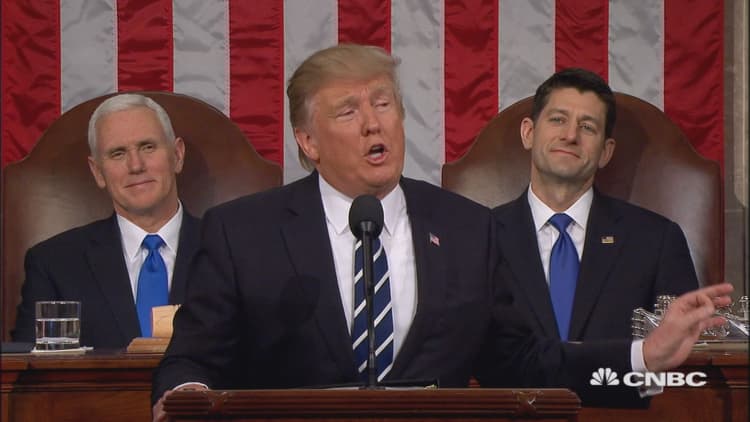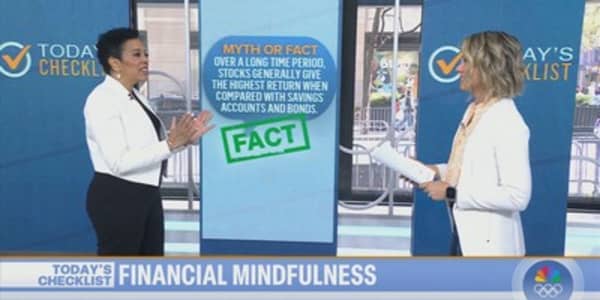
President Donald Trump said in his first speech to a joint session of Congress Tuesday that one of his main principles for replacing the Affordable Care Act is to have health savings accounts play a larger role in helping "Americans purchase their own coverage."
So what exactly is a health savings account?
HSAs, introduced in 2003, offer you triple tax advantages: First, contributions are tax-deductible. Second, those contributions can be invested and grow tax-free. Third, withdrawals aren't taxed as long as you use them for qualified medical expenses, such as doctor's visits, prescription drugs and dental care.
For older account holders, you can use your HSA to pay for Medicare premiums and out-of-pocket expenses including deductibles, co-pays and coinsurance (except Medigap).
If you use an HSA to pay for unqualified medical expenses, the tax penalty is 20 percent, unless you are 65 or older. At that age, you can take money out for whatever you want, but the withdrawals will still be subject to regular income taxes.
A drawback of HSAs is that currently they must be paired with a high-deductible health plan. Such a plan means you'll have to pay a deductible of at least $1,300 for individual coverage and $2,600 for families. The maximum annual out-of-pocket costs for these plans are $6,550 for individuals and $13,100 for families.
In 2017, you (and your employer) can contribute up to $3,400 to an HSA for individuals and $6,750 for families. Account holders age 55 and older can contribute an extra $1,000.
Even without Trump, HSA accounts are growing
Health savings accounts have grown to an estimated $37 billion in assets and 20 million accounts at the end of last year and reached $41 billion in assets during January, according to Devenir, an HSA consulting firm in Minneapolis.
Given the momentum behind HSAs, Devenir forecasts assets in the accounts could reach more than $53 billion by 2018, a 30 percent increase from 2017. (See chart below.)
Depending on if and how lawmakers replace the Affordable Care Act, more commonly known as Obamacare, the impact of HSAs could be more substantial.
Under a Republican heath-care regime, HSAs could become central to people's financial lives with account holders using them to fund health and long-term care insurance as well as deductibles, according to a recent report from Bill Limburg, a senior associate at management consulting firm Patpatia & Associates in San Francisco.
Limburg estimates HSAs could easily reach $435 billion by 2021 as up to 25 million people open accounts under an Obamacare replacement.
Congressional plans to expand HSAs
Lawmakers have many plans to use HSAs in a replacement package for Obamacare.
House Speaker Paul Ryan and fellow Republicans want to increase the HSA contribution limits to the maximum out-of-pocket limits for high-deductible health plans. So if those rules were in effect next year, the individual HSA limit would rise to $6,550 from $3,400, and the family contribution limit would grow to $13,100 from $6,750.
House Republicans also want to allow spouses to make catch-up contributions to the same HSA account, and permit qualified medical expenses incurred before HSA-qualified coverage begins to be reimbursed from an HSA as long as the account is established within 60 days.
Republican Senators Bill Cassidy of Louisiana and Susan Collins of Maine have introduced a bill to create the Roth HSAs to help people pay health insurance premiums and out-of-pocket costs.
However, Republican lawmakers have yet to build consensus around a unified plan to repeal and replace Obamacare and what that means for HSAs.
How to pick an HSA
You don't have to wait on Congress or President Trump to open an HSA.
Unlike flexible spending accounts, you don't have to "use it or lose it" with an HSA each year. In fact, more than three-quarters of HSA account holders withdrew less than they contributed, and 24 percent didn't touch any money from their accounts, according to a 2015 Fidelity Investments analysis of the more than 500,000 accounts it administers.
Devenir estimates that about 10 percent of the roughly 20 million HSA account holders have a balance of $5,000 or more and 4 percent of people are using their HSAs as investment plans.
Your employer may direct you to sign up with their preferred HSA provider, but if you are enrolled in a qualified high-deductible health plan, you can choose whatever provider you want. However, if employers only offer matching HSA contributions to their preferred provider, it makes sense to stick with them.
HSAs can travel with you if you change jobs or insurers. Just like with any retirement account, fees and investment options matter.
Use HSASearch, which is run by Devenir, to comparison-shop for more than 320 providers. Most HSAs will require that you have at least $1,000 in the account before you can begin put money into investing options, such as stock and bond funds.






